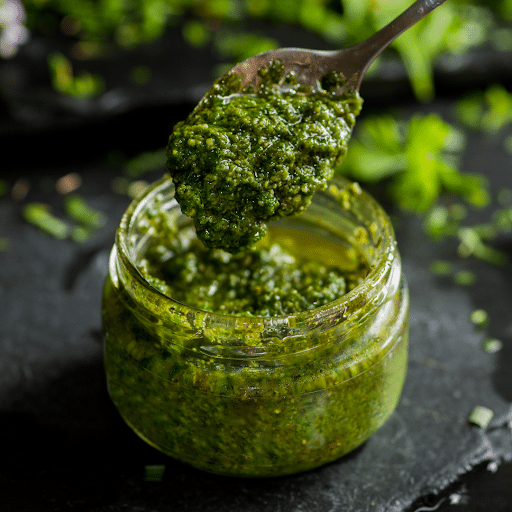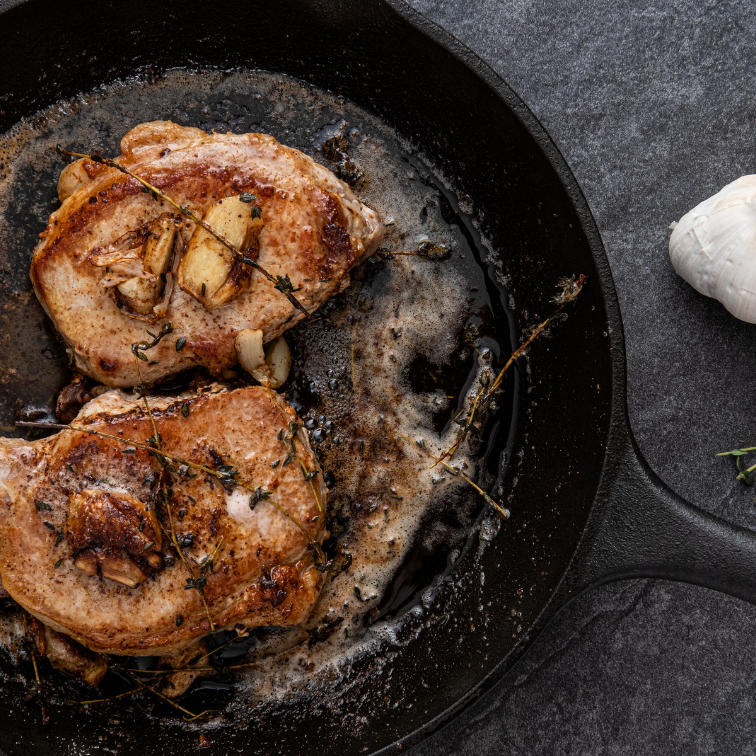One of my favorite things about summertime is having plenty of fresh basil around. Last summer I used so much basil that I decided to get two plants this year.
It’s one of my favorite herbs because of how versatile it is.
I love using it for caprese salads, as a pizza topping, for making herbed butter, in salad dressings, for infused oils and vinegars, and even as a garnish in cocktails.
But one of my favorite uses for fresh basil is making pesto.
When making homemade basil pesto, one common question often arises: can you use the basil stems?
Today, I’m going to explore the role of basil stems in pesto and provide helpful tips for home cooks.
Understanding the Basil Plant
The basil plant is a staple in many kitchens, known for its aromatic leaves and versatility in various dishes. When using fresh basil leaves for recipes like pesto, many people discard the stems.
But this isn’t necessary!
Understanding the entire basil plant, including the stems, can open up new possibilities in your cooking. The stems, much like the leaves, carry the distinct basil flavor that can add depth to your dishes.
The Role of Basil Stems in Pesto
Basil stems are often overlooked in pesto recipes, but they can be a valuable addition. While some believe that thicker stems can introduce bitter flavors, tender stems can blend well and add a depth of flavor to your pesto sauce. Incorporating basil stems can also be a great way to make use of the whole thing, reducing waste and maximizing the yield from your basil plant.

Making Classic Basil Pesto with Stems
Creating a classic basil pesto recipe can be a delicious way to use the whole plant, including basil stems. Here’s a step-by-step guide to making homemade basil pesto using both leaves and tender stems, ensuring you don’t waste any part of your basil plant.
Fresh basil leaves and tender stems: These provide the signature aromatic and fresh flavor essential for any classic pesto sauce. Using tender stems can add extra depth and reduce waste.
Pine nuts: These nuts add a creamy texture and a subtle, nutty flavor that balances the fresh basil. They are a traditional ingredient in pesto recipes.
Garlic cloves: Fresh garlic cloves give the pesto a pungent kick and enhance the overall savory profile of the sauce.
Parmesan cheese: Grated Parmesan cheese adds a rich, salty flavor that complements the basil and nuts, providing a necessary umami component to the pesto.
Extra virgin olive oil: This is the base of the pesto, tying all the ingredients together with its smooth, fruity flavor. It helps create the desired consistency and richness.
A little salt: A pinch of salt brings out the flavors of the other ingredients, enhancing the overall taste of the pesto.
Lemon juice: (optional) Adding a splash of lemon juice can brighten the flavors and add a subtle tanginess that complements the richness of the pesto.
These ingredients work together to create a pesto sauce that’s bursting with fresh flavor. The pine nuts add a creamy texture, while the garlic cloves and Parmesan cheese provide a savory depth. Extra virgin olive oil ties everything together, creating a smooth paste that’s perfect for a variety of dishes.

The Benefits of Using Basil Stems
Incorporating basil stems in your pesto not only reduces waste but also adds a unique texture and flavor. Basil stems are packed with nutrients and contribute to the overall flavor of the basil. Using stems can also make your pesto thicker and more robust, which can be a good addition depending on how you plan to use the pesto.
Tips for Preparing Basil Stems
Before adding basil stems to your pesto, proper preparation is crucial. Here are some tips:
- Trim Thicker Stems: Remove any tough, woody parts of the stems as they can be bitter and hard to blend.
- Wash Thoroughly: Ensure the stems are clean and free from any dirt or insects.
- Chop Finely: Chop the stems into small pieces to help them blend smoothly into the pesto.
These steps will help you make the most of your basil stems, ensuring they integrate seamlessly into your pesto sauce.
Balancing Flavors in Pesto
Balancing the flavors in your pesto is essential, especially when incorporating basil stems.
Here are some tips:
- Lemon Juice: Add a splash of lemon juice to brighten the flavors and balance the richness of the olive oil.
- Black Pepper: A pinch of black pepper can add a subtle kick that complements the garlic and Parmesan cheese.
- Parmesan Cheese: Adjust the amount of Parmesan cheese to taste. It adds a salty, nutty flavor that’s essential in classic basil pesto.
- Experimenting with these ingredients can help you achieve the best flavor for your homemade pesto.
Alternative Ingredients for Pesto
If you’re looking to experiment with your pesto, consider using alternative ingredients:
- Sunflower Seeds: Substitute pine nuts with sunflower seeds for a different flavor and texture.
- Pecorino Romano: Use Pecorino Romano cheese instead of Parmesan for a sharper, saltier taste.
- Thai Basil: Try using Thai basil for a unique twist on the traditional recipe.
These alternatives can add a fresh twist to your pesto, allowing you to explore new flavor combinations.
Storing and Freezing Pesto
Proper storage of your homemade pesto is key to maintaining its fresh flavor. Here are some tips:
- Air-tight Containers: Store pesto in air-tight containers to prevent oxidation.
- Freezer Bags: For long-term storage, freeze pesto in small batches using freezer bags or ice cube trays.
- Thin Layer of Olive Oil: Pour a thin layer of olive oil on top of the pesto before storing to help preserve its vibrant green color.
This way, you can enjoy your homemade basil pesto for weeks or even months.

Creative Uses for Pesto
- Spread on Fresh Bread: Use pesto as a flavorful spread on fresh bread or sandwiches.
- Salad Dressing: Mix pesto with a little more lemon juice and olive oil to create a delicious salad dressing.
- Tomato Salads: Drizzle pesto over fresh tomato salads for a burst of flavor.
- Spaghetti Squash: Toss roasted spaghetti squash with pesto for a healthy and tasty meal.
- Pizza Topping: Dollop pesto onto your pizza for an extra layer of flavor.
- Marinade: Use pesto as a marinade for chicken, fish, or vegetables before grilling or roasting.
- Stuffed Chicken: Spread pesto inside chicken breasts before baking for a flavorful stuffed chicken dish.
- Pesto Butter: Mix pesto with softened butter and use it as a topping for steaks, fish, or vegetables.
- Soup Garnish: Swirl pesto into soups like minestrone or vegetable soup for added depth and flavor.
- Eggs: Stir pesto into scrambled eggs or drizzle over an omelet for a herby twist.
- Risotto: Stir pesto into a creamy risotto for a vibrant green hue and fresh taste.
- Toss with Vegetables: Mix pesto with roasted or steamed vegetables for a quick and flavorful side dish.
- Pasta Salad: Use pesto as the dressing for a cold pasta salad with fresh vegetables and cheese.
- Grilled Cheese: Spread pesto on the inside of a grilled cheese sandwich before cooking for an elevated flavor.
- Dips: Mix pesto with Greek yogurt or sour cream for a quick and easy dip.
- Burger Condiment: Spread pesto on your burger buns for an herbaceous addition to your favorite burger.
- Baked Potatoes: Top baked potatoes with a dollop of pesto for a fresh and flavorful twist.
- Seafood: Drizzle pesto over grilled or baked fish for a Mediterranean flair.
- Pesto Hummus: Stir pesto into hummus for a vibrant and tasty variation.
- Appetizer Skewers: Use pesto as a dipping sauce for skewers of mozzarella, cherry tomatoes, and basil.
- Avocado Toast: Spread a thin layer of pesto on avocado toast for an extra burst of flavor.
- Pesto Mayo: Mix pesto with mayonnaise and use it as a sandwich spread or a dip for fries.
- Grain Bowls: Add a spoonful of pesto to grain bowls with quinoa, rice, or farro for added flavor.
- Stuffed Peppers: Mix pesto with rice or quinoa and use it to stuff bell peppers before baking.
- Taco Topping: Drizzle pesto over tacos for a fresh and unexpected twist.
- Flatbreads: Use pesto as a base sauce for flatbreads or naan pizzas.
- Bruschetta: Top bruschetta with pesto, fresh tomatoes, and a sprinkle of Parmesan cheese.
- Cheese Platter: Serve pesto alongside a cheese platter with a variety of cheeses, crackers, and fruits.
- Squash: Toss with roasted spaghetti squash for a healthy and tasty meal.
These ideas can help you get the most out of your pesto, adding variety to your meals.
Whether you’re a seasoned home cook or trying pesto for the first time, incorporating basil stems can enhance your pesto’s flavor and texture. With the right preparation and balance of ingredients, you can create a delicious and versatile pesto sauce that’s perfect for a variety of dishes. Happy cooking!










